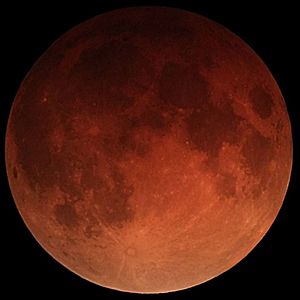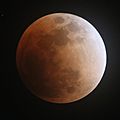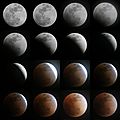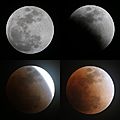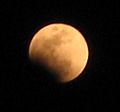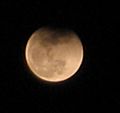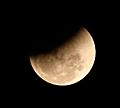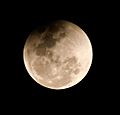January 2018 lunar eclipse facts for kids
On January 31, 2018, a special event happened in the sky: a total lunar eclipse. This eclipse was extra unique because the Moon looked like a supermoon. A supermoon happens when the Moon is at its closest point to Earth, called perigee. This makes the Moon look a bit bigger and brighter than usual.
It was also the first blue moon eclipse of 2018. A blue moon is the second full moon in a single calendar month. Because it was a supermoon, a blue moon, and a total lunar eclipse (which often makes the Moon look reddish, like a "blood moon"), people called it the super blue blood moon.
Contents
What is a Lunar Eclipse?
A lunar eclipse happens when the Moon passes through Earth's shadow. Imagine the Earth blocking the Sun's light from reaching the Moon. This creates a shadow.
As the eclipse starts, Earth's shadow slowly covers the Moon. The Moon doesn't disappear completely. Instead, it often turns a dark red-brown color. This happens because of something called Rayleigh scattering. It's the same reason sunsets look red! Earth's atmosphere bends some of the Sun's light and sends it towards the Moon, making it appear reddish.
Where Could People See It?
Best Views Across the World
Many people around the world got to see this amazing lunar eclipse. The Pacific Ocean was facing the Moon during the eclipse. This meant that Central and eastern Asia (like most of Siberia), the Philippines, Indonesia, New Zealand, and most of Australia had a great view in the evening sky.
If you were in western Asia, the Indian subcontinent, the Middle East, or Eastern Europe, the eclipse had already started as the Moon rose.
How it Looked from the United States
Along the U.S. West Coast, the total part of the eclipse began at 4:51 a.m. PST. The further east you were in the U.S., the closer the eclipse was to ending as the Moon set.
The total eclipse lasted for 77 minutes. During this time, the Moon moved through the lower part of Earth's shadow. This made the bottom edge of the Moon look much brighter than its darker top edge during the total eclipse.
 View of Earth from the Moon during the eclipse |
 Map showing where the eclipse was visible |
When Did It Happen?
This table shows the different times the eclipse stages happened in various time zones around the world.
| Eclipse | HST | AKST | PST | MST | CST | EST | UTC | MSK | IST | ICT | CST | JST | AEDT | NZDT |
|---|---|---|---|---|---|---|---|---|---|---|---|---|---|---|
| Zone from UTC | −10 h | −9 h | −8 h | −7 h | −6 h | −5 h | 0 h | +3 h | +5½ h | +7 h | +8 h | +9 h | +11 h | +13 h |
| Penumbral eclipse begins | 00:51 | 01:51 | 02:51 | 03:51 | 04:51 | 05:51 | 10:51 | 13:51 | — | 17:51 | 18:51 | 19:51 | 21:51 | 23:51 |
| Partial eclipse begins | 01:48 | 02:48 | 03:48 | 04:48 | 05:48 | 06:48 | 11:48 | 14:48 | 17:18 | 18:48 | 19:48 | 20:48 | 22:48 | 00:48 |
| Total eclipse begins | 02:52 | 03:52 | 04:52 | 05:52 | 06:52 | — | 12:52 | 15:52 | 18:22 | 19:52 | 20:52 | 21:52 | 23:52 | 01:52 |
| Mid-eclipse | 03:30 | 04:30 | 05:30 | 06:30 | — | — | 13:30 | 16:30 | 19:00 | 20:30 | 21:30 | 22:30 | 00:30 | 02:30 |
| Total eclipse ends | 04:08 | 05:08 | 06:08 | 07:08 | — | — | 14:08 | 17:08 | 19:38 | 21:08 | 22:08 | 23:08 | 01:08 | 03:08 |
| Partial eclipse ends | 05:11 | 06:11 | 07:11 | — | — | — | 15:11 | 18:11 | 20:41 | 22:11 | 23:11 | 00:11 | 02:11 | 04:11 |
| Penumbral eclipse ends | 06:08 | 07:08 | — | — | — | — | 16:08 | 19:08 | 21:38 | 23:08 | 00:08 | 01:08 | 03:08 | 05:08 |
Photo Gallery
Total or Near Total Eclipse Views
-
From Tokyo, Japan
-
From Kerala, India
-
Another view from Kerala, India
-
From Victoria, Australia, at 12:44am AEST
-
From Chiang Mai, Thailand at 7:56 PM ICT. Shows two views: how the camera saw it and how people saw it.
-
From Victoria, Australia, at 11:48pm AEST
-
From Victoria, Australia, at 1:14am AEST
Montages of the Eclipse
Partial Eclipse Views
More Images
-
Example from Aichi Prefecture, Japan: 1. Penumbral lunar eclipse at 8:23 PM (JST) 2. Partial lunar eclipse at 9:13 PM (JST) 3. Partial lunar eclipse at 9:43 PM (JST) 4. Total lunar eclipse (blood moon) at 9:55 PM (JST)
-
From Fayetteville, North Carolina, at 11:36 UTC
-
From Melbourne, Florida, at 12:00 UTC
-
From Jacksonville, Florida, at 12:10 UTC
-
From Macon, Georgia, at 12:11 UTC
-
From Tula, Tamaulipas, at 12:29 UTC
-
From Houston, Texas, at 12:41 UTC
-
From Dallas, Texas, at 12:51 UTC
-
Totality from Southern California, at 12:58 UTC
-
From Denver, Colorado, at 12:59 UTC
-
From Yellowstone National Park, at 1:03 PM UTC
-
From Placitas, New Mexico, at 1:35 PM UTC
-
From Redwood City, California, at 1:43 PM UTC
-
From Novato, California, at 2:13 PM UTC
-
From Landers, California at dawn
-
Partial eclipse from Ilagan, Isabela
-
From Hiroshima, Japan, at 11:43 UTC
-
From Shinjyuku, Tokyo, at 12:52 UTC
-
From Guangzhou, China, at 1:50 PM UTC
-
From Novosibirsk, Russia, at 2:06 PM UTC
-
From George Town, Malaysia, at 2:16 PM UTC
-
From Singapore, at 2:32 PM UTC
-
From the Russian Far East
-
From Sydney, Australia, at 12:49 UTC
See also
 In Spanish: Eclipse lunar de enero de 2018 para niños
In Spanish: Eclipse lunar de enero de 2018 para niños


